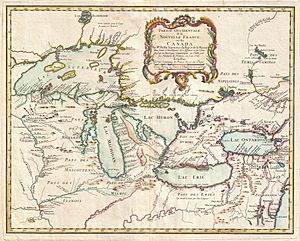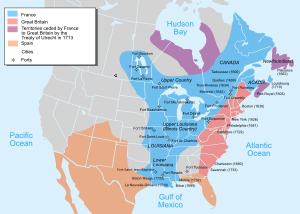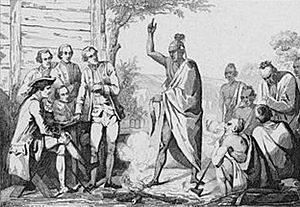Franco-Indian alliance facts for kids
| Foreign alliances of France | |||||||||||||||||||||||||||||||||||||||||||||||||||||||||||
|---|---|---|---|---|---|---|---|---|---|---|---|---|---|---|---|---|---|---|---|---|---|---|---|---|---|---|---|---|---|---|---|---|---|---|---|---|---|---|---|---|---|---|---|---|---|---|---|---|---|---|---|---|---|---|---|---|---|---|---|
|
|||||||||||||||||||||||||||||||||||||||||||||||||||||||||||
The Franco-Indigenous Alliance was a partnership between French settlers and various North American indigenous nations (Native American groups). It was mainly in the Great Lakes area and the Illinois country. This alliance was important during the French and Indian War (1754–1763).
The alliance included French settlers and Native American peoples like the Abenaki, Odawa, Menominee, Winnebago, Mississauga, Illinois, Sioux, Huron, Petun, and Potawatomi. This partnership helped the French and Native Americans create a safe area in the middle-Ohio Valley before major conflicts started.
Contents
A Long Friendship: French and Native Americans
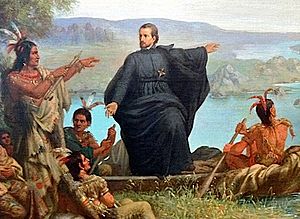
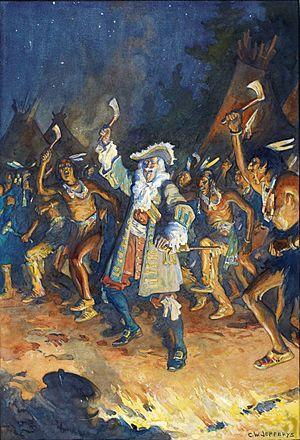
France had been in North America for a long time, starting with New France in 1534. The French tried to get Native Americans to adopt their culture and the Catholic faith. This was often done through Jesuit missionaries.
Unlike other European powers, France wanted to live peacefully with Native Americans. A French law from 1627 said that Native Americans who became Catholic were considered "natural Frenchmen." This meant they had the same rights as French citizens.
The historian Francis Parkman once said that while other European groups often harmed or ignored Native Americans, the French welcomed and valued them.
Sharing Cultures and Customs
French officials often adopted Native American habits to gain their trust and support. For example, the Baron de Saint-Castin was adopted by an Abenaki tribe and married a Native American woman. Governor Frontenac even danced and sang war songs at a Native American council.
Native Americans also adopted French customs. Chief Kondiaronk wanted to be buried in his French captain's uniform. Kateri Tekakwitha became a Catholic saint.
French settlers and Native Americans fought together in many wars before the Seven Years' War. These included Father Rale's War, King George's War, and Father Le Loutre's War. Marriages between French settlers and Native Americans were also common, leading to the Métis people.
The Seven Years' War and Its End
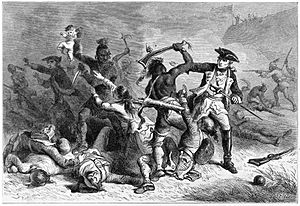
In the 1700s, there were many more British settlers than French settlers in North America. This made it very important for France to ally with most of the Native American nations. One French observer noted that all Native American nations were asked to help the French fight the British.
At the start of the war, the French and their allies won some important battles. These included the Battle of Fort Necessity and the Battle of the Monongahela. After the capture of Fort William Henry, the French commander, Marquis de Montcalm, allowed the British soldiers to leave safely. However, some Native American allies did not understand this agreement and attacked the British as they left.
The Alliance Weakens
France faced major defeats in Europe during the Seven Years' War. Its navy also struggled against the British Royal Navy. This meant France could not properly send supplies and support to the Canadiens and their Native American allies.
The British started winning more battles, like the Battle of Fort Niagara. At the same time, the British began promising support and protection to Native American groups. Because of these challenges, the Franco-Indigenous alliance slowly began to break apart. Finally, the city of Quebec fell to the British in September 1759 after the Battle of the Plains of Abraham.
When the Seven Years' War ended in 1763, New France was divided. Canada went to the British, and Louisiana went to the Spanish.
After the Alliance
Even after New France ended in 1763, communities of French and Native American people continued to exist. They often kept their Catholic faith, spoke French, and used French names. From the Saint Lawrence River to the Mississippi River, these mixed communities included Native Americans and Blacks.
During the American War of Independence, the French once again teamed up with Native American troops. An example is the Battle of Kiekonga in 1780.
Later, in 1869 and 1885, Louis Riel led two revolts by the Métis people against the Canadian government. These revolts, known as the Red River Rebellion and the North-West Rebellion, were put down, and Riel was executed.


